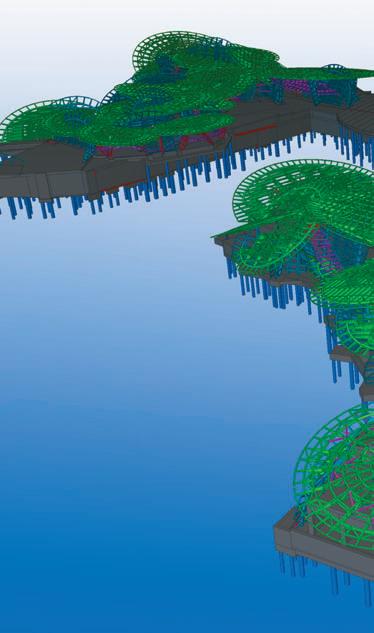
4 minute read
for change
BIM software: a catalyst for change
Rob Charlton, CEO of space architecture, looks to the cloud and the process changes required for real time integration of the design team.
The UK construction industry is notoriously conservative and reluctant to invest. Only a small number of companies saw the early potential of Building Information Modelling (BIM) and decided to take a lead. Organisations like our own were fascinated by the potential and skilled our whole team in the new way of working. Construction companies such as Laing O’Rourke were also early adaptors and pushed the technology through its business.
It took until mid 2011 for BIM to become mainstream in the UK. The announcement by the UK government in May 2011 that all government-funded projects would be delivered in BIM by 2016 legitimised the technology and approach.
Paul Morrell from the government task force significantly raised awareness, but more importantly demonstrated that BIM was not going to go away.
Right across the industry from designers to builders and clients there is a varying level of adoption.
At consultant level all professions are aware of the technology and are adopting it at different paces. Large practices are making a commitment with smaller practices taking a more cautious approach. Builders are now aware of BIM and their commitment ranges from a reactive response when required Rob Charlton space architecture This is largely a replication of how design management and development has progressed for many years only through to pro-active invest- using models as opposed to ment in research and devel- 2-dimensional information. opment. We are now moving
We have moved into a peri- towards Level 3 BIM, which od where clients are starting will not only require that the to appreciate the benefits of industry adopts new techniquality building information cal skills in using software in the process of managing but also a change in how risk and importantly managRob Charlton is CEO of procurement and liability is ing their assets and facilities space architecture. He managed. in the long term. was instrumental in the Over a number of years On the level launch of BIM. Technologies in 2011, a specialist technology several of the software developers have been develThe UK government has company supporting the oping cloud-based strategies adopted a range of established levels to identify progconstruction sector and its supply chain. and it is clear that software suites being hosted locally is ress and growth in the matu- ■ spacegroup.co.uk likely to be phased out with rity of BIM. The target for ■ bimtechnologies.co.uk software solutions and stor2016 is that all projects will age being held in the cloud. be delivered to level 2 BIM. This will also provide the
Level 2 BIM is a relatively straightfor- ability to access a wide range of services ward development in that individual and to ensure that information and servicproject teams can still work within their es are current. own authoring software with the indi- It is likely that, rather than making onevidual models being federated into a cen- off capital savings for software, organisatral file and co-ordinated independently. tions will be encouraged to use credits,
Software approaches such as Autodesk Glue 360 working in a Level 3 BIM environment can encourage collaboration through the design stages
which can be utilised on a project-by- share comments and notes via hyperlinks project basis. and pin locations.
This new infrastructure has been a cata- The technology is surprisingly similar lyst to reconsider how not only software to social networking, which will prove needs to be developed but how we familiar to the industry’s emerging talent. approach design co-ordination. When we reviewed the software the
Level 3 BIM encourages design team room was split between designers and members to work together in real time in a builders. Many of the builders had consingle project environment. cerns about the approach with their tra-
This approach clearly challenges everything which has been known in the industry for decades. ‘‘ Previously I have been sceptical
about how Level 3 BIM could be
Cloudy forecast There are a range of new prodachieved. BIM 360 Glue clearly ucts currently being developed demonstrates that real time that use cloud-based solutions and encourage real time integramodel management is achievable tion of a design team. We recently have had the opportunity to review Autodesk BIM 360 ditional methods involving control. ’’ Glue in detail. Every decision is recorded to protect Whilst previously I have been scepti- future liability. cal about how Level 3 BIM could be Software approaches such as Glue achieved. BIM 360 Glue clearly demon- working in a Level 3 environment encourstrates that real time model management age collaboration through the design stagis achievable. es. The key milestones are model delivery Glue allows designers to share informa- packages, which become the baseline contion in real time and provides tools to tractual position. The benefits of continuous dialogue were all too clear to see during our trial. There is no doubt that the technology is more than capable of achieving impressive results however my concern is in adopting completely new practices across the industry. The industry is already struggling to learn new skills in platforms such as Revit and Navisworks. A further need to rethink the design development process will be a challenge. These new technologies require a complete change in mindset. Clients will have to reconsider their appointments, constructors need to rethink their management process and designers need to be flexible and open when working with other members of the design team. As well as BIM 360 Glue there are more products coming to market which will raise similar questions and provide equally exciting solutions. These new cloud-based platforms are likely to form the basis of BIM 2.0. We are already adopting this software on a live project however we are aware that the technology is far more about changing hearts and minds than it is about learning new skills.






